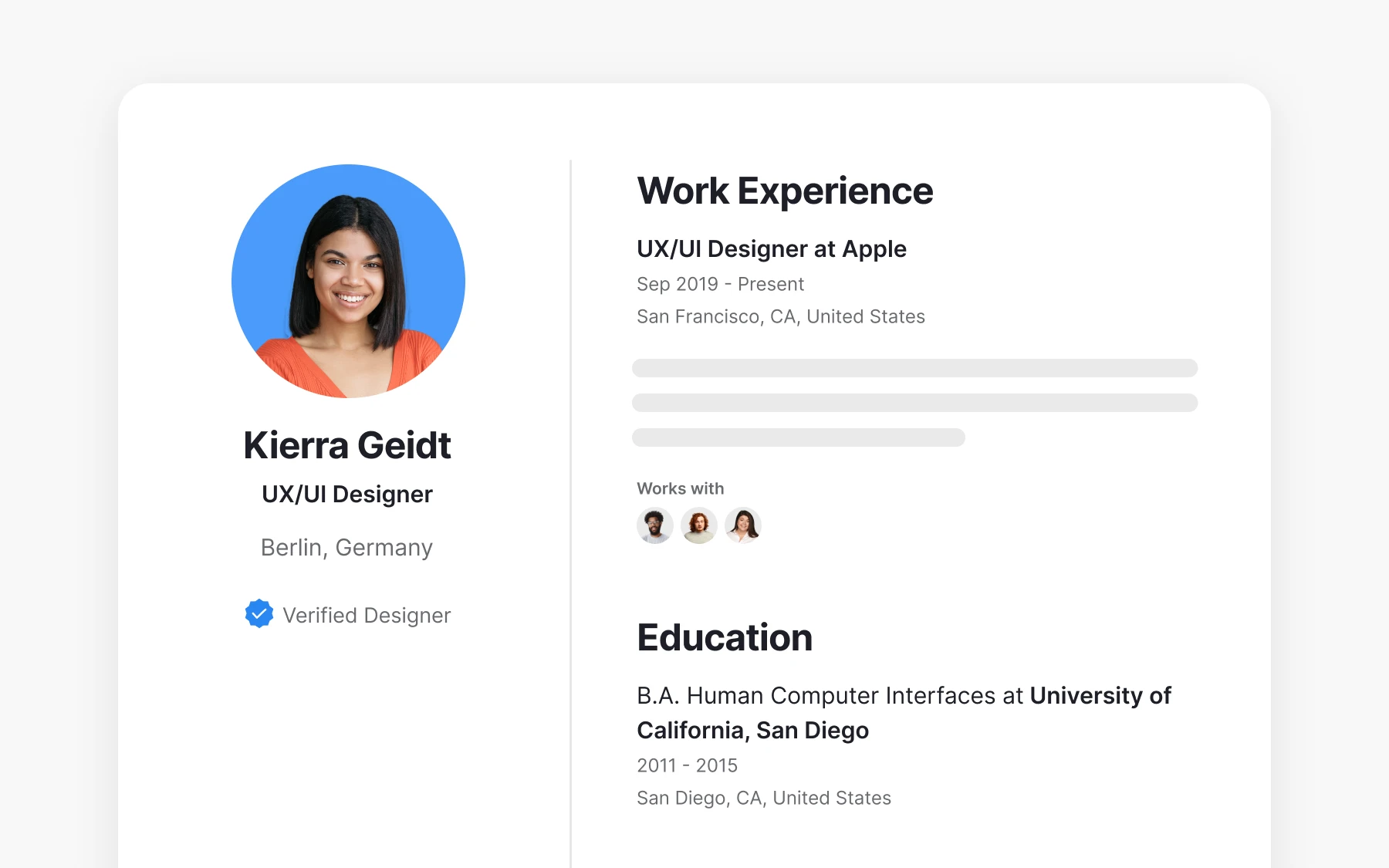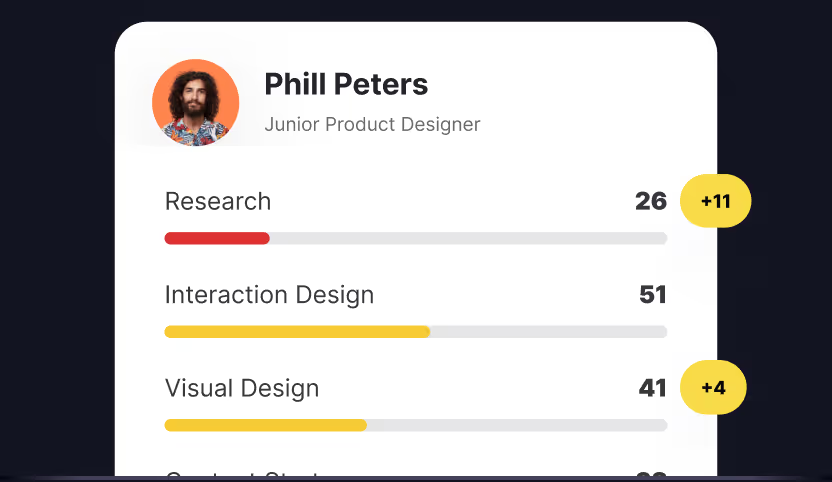
If you’re hunting for a new job as a designer, and constantly browsing UX job boards — it’s tempting to put all of your time and effort into creating an amazing portfolio. But before a hiring manager ever sees your portfolio, they’re likely to look over your resumé first.
Creating a design resumé doesn’t have to be particularly complicated. Be sure to include basic information such as your name, contact details, and professional title so that your resumé clearly presents essential details at a glance. In fact, keeping your resumé simple will get you further in the hiring process than an over-the-top design that may grab attention but won’t necessarily impress hiring managers. Remember, the first person who sees your resumé may not be a designer at all. Just as with designing great websites, designing great resumés requires keeping your user’s needs at the forefront.
Introduction to designer resumes
In today’s competitive market, a well-crafted designer resume is essential for graphic designers aiming to make a strong impression on potential employers. Your resume is more than just a list of jobs — it’s a marketing tool that showcases your unique abilities, technical skills, and qualifications. By tailoring your designer resume to each job description, you can highlight the most relevant experience and education, positioning yourself as the ideal candidate for the role. A good resume not only demonstrates your expertise as a designer but also grabs the hiring manager’s attention, increasing your chances of landing an interview. In this guide, we’ll break down the key elements of a successful designer resume, explore effective structure and formatting, and share tips to help you stand out in your job search.

A great design resumé contains much of the same information as resumés for any other industry. That includes:
Your contact information — Be sure that your contact information is prominent and easy to find on your resumé. It should include your name, phone number, email address, and website or portfolio URL.
Your work experience — This is arguably the most important part of your resume. Include relevant positions you’ve held in the past, along with a summary of your successes in those positions. Be sure to clearly state your job title for each role and highlight your design experience. List your positions in reverse chronological order, starting with your most recent role. Use a bulleted list to present your key achievements and responsibilities, and start each bullet point with action words to make your accomplishments stand out. You don’t need to list responsibilities that are standard for the type of position you held. Instead, focus on results you achieved or projects you’re particularly proud of. If you have gaps in your work history, consider including just the years you stayed in each position, instead of including the exact dates.
Your relevant skills — This is where you want to list any particular design skills you have, as well as the tool stack you’re used to working with. You can include things like user testing, UX design, and mobile design, as well as programs like Figma, Sketch, or Spline here. Be sure to include soft skills alongside your technical skills, such as communication, teamwork, or leadership. If you’ve completed any Uxcel Skill Tests, include those here, too.
Your achievements — Did you work on a project that won an award? Or maybe you spoke at a prominent design conference? These are the kinds of things you’ll want to include in this section. Be sure to highlight relevant experiences that demonstrate your value and expertise.
Your education, qualifications, and certifications — If you have formal design training, list it here. This can include any university or college degree, including the degree name, institution, and graduation date, UX design bootcamps, or certification programs, or any other formal education you have completed. If you’re interested in what you might earn as a design manager, check out the design manager salary in the USA.
On Uxcel, you can take a UX design test or complete professional UX certifications and highlight your achievements and skills on a resumé. You can also upskill to increase your earning potential as a UX designer.
Consider adding additional sections to your resume, such as awards, activities, or professional memberships, to further showcase your qualifications and passions.
Focus on the design
The biggest difference between a designer resumé and a resumé for any other industry is in the design. As a graphic designer, it's essential to be creative in your resume design to stand out and showcase your originality and imaginative skills. This is a chance to show off your design chops in a way that immediately grabs the attention of the hiring manager and potential employer. That said, this is not the time to go wild with your design.
Keep readability at the forefront of your thoughts as you go about designing your resumé. Remember that the first person who looks at your resumé may not be a designer, so they’re going to be more concerned with being able to read your resumé than with the design of it. Write and describe your skills and experience clearly, focusing on relevant information that aligns with job descriptions.
Keep the overall layout simple. Use a template or resume template to ensure a professional and organized appearance. Use color and visual hierarchy to highlight the most important parts, and pay close attention to information architecture. Look at examples and resume examples for inspiration, and consider how your experience spans different industries.
When it comes to formatting, compare using paragraph format versus bulleted lists. Including a short paragraph at the top of your resume is valuable for quickly summarizing your strengths and making an immediate impact.
You’ll most likely want to skip the word processing software for your resumé and instead use a page layout app like Adobe InDesign. Creating a website version of your resumé is also a great idea (and allows for incorporating interactive elements), but be sure you create a standard PDF version as well. This is especially important for showcasing your print design experience and graphic design skills. You’ll need that for submitting applications to most companies. Before submitting, double check your resume for errors, and keep it to one page whenever possible. Conduct research to understand industry trends and employer needs to further tailor your resume for success.
Resume structure and format
A designer resume should be structured for clarity and impact, making it easy for hiring managers to quickly scan and identify your most relevant qualifications. Start with a brief summary or introduction that highlights your strengths as a designer. Follow this with sections for education, work experience, and a dedicated skills section that showcases your technical abilities and key skills. Use bullet points to present your achievements and responsibilities, and make strategic use of white space to keep the document visually appealing and easy to read. Stick to a single page whenever possible, and choose a clean, standard font and layout to ensure your resume is compatible with applicant tracking systems. Incorporating action verbs and concise language will help your professional experience stand out. A well-structured designer resume not only communicates your qualifications but also demonstrates your attention to detail and strong communication skills.
Your cover letter
Along with sending a resumé to potential employers, you’ll also need a great cover letter. It’s important to customize these letters for each job you apply for. In fact, preparing multiple cover letters tailored to different roles or companies can significantly improve your chances, as cover letters are a valuable complement to your resume in job applications. But that doesn’t mean you can’t create a basic version that you can adapt for each position.
The key things to keep in mind when writing a cover letter is that it should be short, briefly summarize your relevant experience and skills, and show the employer that you understand what they’re looking for. Ideally, your cover letter should be no longer than three paragraphs — an introduction paragraph, a paragraph about why you’re a good fit for the position, and a closing paragraph that reiterates your interest in the position and thanks the reader for their consideration.
Your portfolio
Your resumé and cover letter should both include links to your portfolio. And your portfolio should accurately reflect your design skills and feature the best projects you've worked on.
You don't need to include every project you've contributed to. Instead, pick the best, most interesting projects. And then focus on the story behind those projects.
“The most interesting design stories in a UX portfolio are when there is a problem. People will get interested and ask themselves, 'What did the designer do then? How is she going to get out of this? (…) The heart of the story is not the image of the screen, but the story of what we did with it, why we did it, and what user's reactions were.” — Susan Weinschenk
If you're still unsure where to create and host your design portfolio — we'd like to invite you to Uxcel. You can create your free shareable designer portfolio, that is can be enhanced with the skill test and other achievements you've earned on the platform. Also, you can get a personalized profile URL & record a great video introduction! To better understand the impact of UX design, including its ROI and current trends, check out our in-depth article.
To really impress potential employers, keep design elements between your portfolio and your resumé consistent. Using the same basic color palette and typography between the two starts to create a personal brand identity, which employers are more likely to remember. It shows that you treat your career with care, and that you have a personal aesthetic and style. It comes across as more thoughtful and professional than a resumé and portfolio that bear no resemblance to one another. Additionally, make sure you prepare yourself for the interview with going through common UX interview questions.
The design industry is competitive, but the best designers are often presented with multiple job offers. Taking extra time to craft your resumé helps you get noticed by employers and shows that you're serious about your career.
Tips for a successful application
To maximize your chances of success, always tailor your resume to the specific job description. Carefully review the requirements and responsibilities, then highlight the key skills and experiences that align with what the company is seeking. Incorporate relevant keywords from the job description to help your resume pass through applicant tracking systems and catch the hiring manager’s attention. Before submitting your application, proofread your resume with fresh eyes to catch any errors or inconsistencies. Pair your resume with a strong cover letter that provides additional context and expresses your enthusiasm for the position and company. By customizing your application materials and focusing on what makes you the best candidate, you’ll create a compelling case for why you should be invited to interview.
Conclusion
A well-crafted designer resume is a vital part of any graphic designer’s job search strategy. By understanding how to structure your resume, tailoring it to each job description, and using the right keywords, you can set yourself apart from other candidates in a crowded market. Remember, a good resume—supported by a strong cover letter and a standout portfolio — showcases your skills and helps you land interviews for your dream job. Whether you’re an experienced designer or just starting your career, investing time in creating a professional, targeted resume will pay off as you advance in the design industry.




